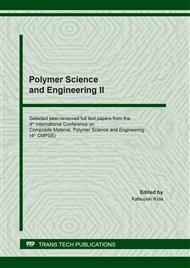[1]
M. R. Ghomashchi, A. Vikhrov, Squeeze casting: an overview, J. Mater. Process. Technol., 101 (2000) 1-9.
Google Scholar
[2]
R. X. Li, L. J. Liu, L. J. Zhang, J. H. Sun, Y. J. Shi, and B. Y. Yu, Effect of squeeze casting on microstructure and mechanical properties of hypereutectic Al-xSi alloys, J. Mater. Sci. Technol., 33 (2017) 404-410.
DOI: 10.1016/j.jmst.2017.02.004
Google Scholar
[3]
X. H. Ao, S. M. Xing, B. S. Yu, and Q. Y. Han, Effect of Ce addition on microstructures and mechanical properties of A380 aluminum alloy prepared by squeeze-casting, Int. J. Miner. Metall. Mater., 25 (2018) 553-564.
DOI: 10.1007/s12613-018-1602-y
Google Scholar
[4]
S. Ganguly and A. K. Mondal, Influence of SiC nanoparticles addition on microstructure and creep behavior of squeeze-cast AZ91-Ca-Sb magnesium alloy, Mater. Sci. Eng. A, 718 (2018) 377-389.
DOI: 10.1016/j.msea.2018.01.131
Google Scholar
[5]
W. Y. Wu, D. H. Wang, P. R. Deng and Y. G. Cao, Microstructure and mechanical behavior of squeeze casting Mg-8Gd-2Y-0.4Zr alloy, J. Wuhan Univ. Technol-Mater. Sci. Ed, 33 (2018) 466-471.
DOI: 10.1007/s11595-018-1846-3
Google Scholar
[6]
M. H. Sarfraz, M. Jahanzaib, W. Ahmed and S. Hussain, Multi-response parametric optimization of squeeze casting process for fabricating Al 6061-SiC composite, Int. J. Adv. Manuf. Technol., 102 (2019) 1-4.
DOI: 10.1007/s00170-018-03278-6
Google Scholar
[7]
L. Khizhnyakova, M. Ewering, G. Hirt, K. Bobzin and N. Bagcivan, Metal flow of die wear in semi-solid forging of steel using coated dies, T. Nonferr. Metal. Soc., 20 (2010) 954-960.
DOI: 10.1016/s1003-6326(10)60613-9
Google Scholar
[8]
R. Ahmed, A. Helen, Thixoforming Steel, first ed., Shaker Verlag, Aachen, (2010).
Google Scholar
[9]
A. A. Gomez-Gallegos, M. Farrell, N. Zuelli and A. Staiano, A comparative study assessing the wear behavior of different ceramic die materials during superplastic forming, Materialwiss. Werkstofftech., 48 (2017) 983-992.
DOI: 10.1002/mawe.201700044
Google Scholar
[10]
Q. W. Li, X. H. Hua, Study on Al2O3/ZrO2 metal-ceramic compound die materials, China Ceram., 50 (2014) 70-73.
Google Scholar
[11]
B. A. Behrens, M. Kazhai and T. Prüß, Potentials of ceramic die materials for isothermal forging purposes of a titanium alloy, Key Eng. Mater., 202 (2014) 611-612.
DOI: 10.4028/www.scientific.net/kem.611-612.202
Google Scholar
[12]
S. S. Jiang, K. F. Zhang, Study on controlling thermal expansion coefficient of ZrO2-TiO2 ceramic die for superplastic blow-forming high accuracy Ti-6Al-4V component, Mater. Des., 30 (2009) 3904-3907.
DOI: 10.1016/j.matdes.2009.03.023
Google Scholar
[13]
S. S. Jiang, K. F. Zhang, Superplastic forming of Ti6Al4V alloy using ZrO2-TiO2 ceramic die with adjustable linear thermal expansion coefficient, Tran. Nonferr. Metal. Soc., 19 (2009) 418-422.
DOI: 10.1016/s1003-6326(10)60081-7
Google Scholar
[14]
C. H. Xu, M. D. Yi and R. B. Zhang, Development of ZrO2 based nanoceramic die material with nanometer Ti(C7N3), J. Synthetic Cryst., 42 (2013) 747-750.
Google Scholar
[15]
G. C. Xiao, C. H. Xu, Z. Q. Chen, B. Fang and G. F. Wei, Research on the hot pressing parameters of Ti (C, N)/Al2O3 nanocomposite ceramic die material and the material fabrication, Key Eng. Mater., 589-590 (2013) 594-599.
DOI: 10.4028/www.scientific.net/kem.589-590.594
Google Scholar
[16]
C. H. Xu, G. C. Xiao, R. B. Zhang and Y. M. Feng, Research on the advanced ceramic die materials and their properties, Eng. Mater., 375-376 (2008) 133-137.
Google Scholar
[17]
J. J. Zhang, C. H. Xu and H. F. Zhang, The hot pressing process optimization of Ti(C, N) matrix nanocomposite ceramic die materials with the back propagation neural network and immune genetic algorithm, Adv. Mat. Res., 652-654 (2013) 2086-2092.
DOI: 10.4028/www.scientific.net/amr.652-654.2086
Google Scholar
[18]
S. K. Zhao, C. H. Xu, Effects of CeO2 on the mechanical property and microstructure of 3Y-TZP nano-composite ceramic die material, Key Eng. Mater., 434-435 (2010) 42-44.
DOI: 10.4028/www.scientific.net/kem.434-435.42
Google Scholar
[19]
Y. Li, Study on Application of metal-ceramic compound die materials used in die-casting die, Hot Work. Technol., 43 (2014) 41-43, 46.
Google Scholar


